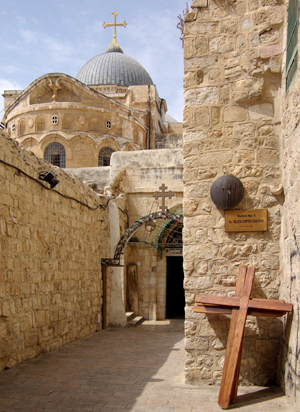
This Easter, Christians all around the world, particularly those of the Roman Catholic denomination, will take part in a solemn devotion known as the ‘Stations of the Cross’. But where did the tradition come from and what’s its purpose? DAVID ADAMS reports…
This Easter, Christians all around the world, particularly those of the Roman Catholic denomination, will take part in a solemn devotion known as the ‘Stations of the Cross’. But where did the tradition come from and what’s its purpose?

The Ninth Station – Traditionally, where Jesus fell for the third time on the Via Dolorosa in Jerusalem. PICTURE: Berthold Werner/Wikipedia (CC BY-SA 2.0): Image cropped
• There are traditionally 14 Stations of the Cross (Latin – Via Crucis), each of which represents a different moment from the day Jesus Christ was crucified, starting with Jesus being condemned to death by Pontius Pilate and ending with Jesus’ body being laid in the tomb.
• The physical stations are usually represented by a cross and perhaps an image or statue depicting the moment being recalled. The idea is that Christians move from one to the other and pause to pray or spend a moment in reflection on a particular aspect of the Passion of Christ at each. A series of set texts may also be read.
• The tradition has its origins in pilgrimages made to Jerusalem in which pilgrims would retrace the steps of Christ along the Via Dolorosa, the Way of Sorrows or Way of Suffering. By the mid-15th century, this pilgrimage had become somewhat organised with set places at which the pilgrims would pause to recall the events of that day that forever changed the earth.
• Because not all could get to Jerusalem, the idea developed of replicating the walk along the Via Dolorosa in places where people lived and so the Stations of Cross began to be recreated at other locations, initially across Europe where the concept was particularly promoted by Franciscan friars.
• The Stations of the Cross are often located inside churches but can also be found in churchyards or, as is the case in Melbourne, Australia, spread across several churches located throughout the city or located at wayside locations.
• Only eight of the traditional 14 stations have solid Scriptural support. Those that don’t include stations three, seven and nine, all of in which Christ is depicted falling, station four in which Christ meets His mother, and station six in which Christ’s face is wiped by Veronica while station 13 – which traditionally depicts Christ being taken off the Cross and laid in his mother’s arms – seems somewhat at odds with the Scriptural record that Christ was taken down from the cross and buried by Joseph of Arimathea.
• In a bid to address the lack of Scriptural support from some of the traditional stations, in 1991 Pope John Paul II introduced a new form of the devotion for Roman Catholics, known as the Scriptural Stations of the Cross (also known as the Scriptural Way of the Cross or in Latin, Via Lucis). In this version, the stations mentioned above are replaced with events taken directly from Scripture.
• Devotions involving the Stations of the Cross, thanks to its focus on the death of Jesus Christ, are particularly popular on Good Friday and during Holy Week but are also popular at other times during Lent.
• While the devotion is most commonly carried out in Roman Catholic churches, it is now known in some Protestant churches including some Anglican, Lutheran and Methodist churches. Some churches also take part in a complementary Stations of the Resurrection which encourages meditation on the resurrection and subsequent Earthly appearances of Jesus Christ.
• Among the most high profile Stations of the Cross processionals is that carried out by the Pope at the Colosseum in Rome on Good Friday.
Sources: Loyola Press, Catholic Online, New Advent, Christian Research Institute, Catholic News Agency





